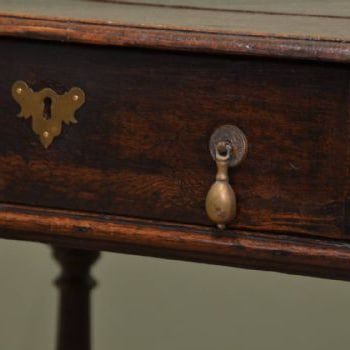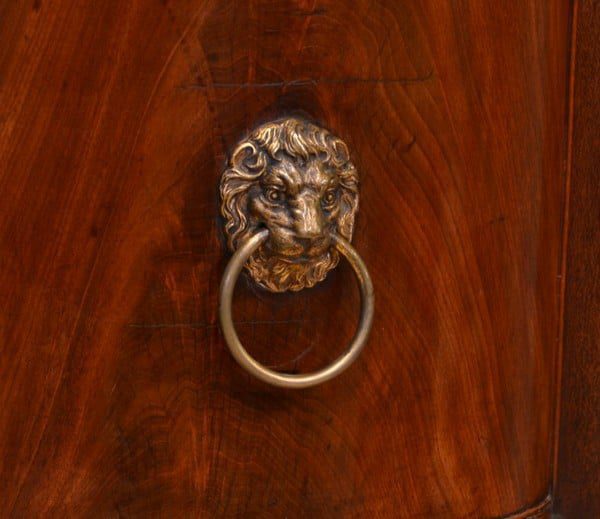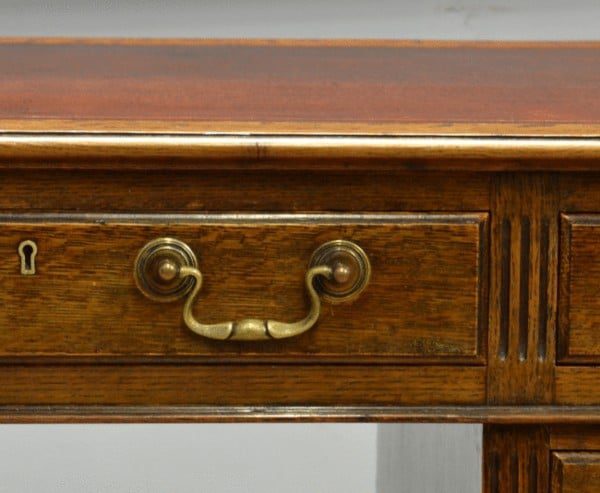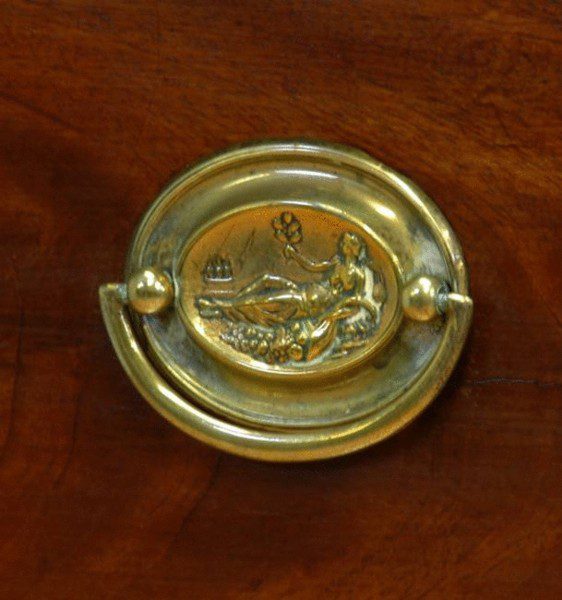The types of handles used on antique furniture changed throughout history, mainly because of materials that was available, more skilful methods developed to create them and due to ever changing fashions.

Wooden Knobs were first used on drawer furniture in the seventeenth century oak period until about 1660, when brass drops were introduced. Brass drops rapidly came into use on oak and walnut furniture from 1660-1710 period. The handle on these pulls was linked to a double strip of brass or iron which passes through the drawer front and was then parted and turned over so that each end was pinned to the drawer back.

From about 1690 the brass loop handle with solid back plate appeared. The back plate was often shaped and could be engraved and the loop was cast and sometimes moulded. Brass knob shaped sockets on the face of bolts held the loop ends.

By 1740 the ‘Swan Neck’ handle, which is often associated with cock beaded drawers, had been introduced. This type of handle the loop is thicker and there are merely two metal moulded circular roses behind each bolt head.

Around 1780 the stamped brass back plate in oval or circular form associated with Hepplewhite or Sheraton furniture came into use. This would be made from thin sheet brass, stamped to shape and hence hollow at the back.

Around the 1800’s the turned wooden knob came into use and by the time the Victorian period had set in, most drawer furniture had wooden knobs of varied simplicity or complication. Some had a simple wooden spigot to fit into the drawer front, some knobs had a wooden threaded screwed spigot and others had a metal bolt put into them.

From about 1880 on-wards, it was necessary to return to brass handles again, although wooden knobs continued to be fitted to ordinary furniture. There was also more elaborate designs such as the Glass Knob appearing on highly decorated and usually carved Victorian Furniture.

13 Comments. Leave new
I’m looking for replacement piece for a wooden knob with wood button-type latch for a door on my tiger oak buffet. The inner screw type mechanism is broken. The side board/buffet has a mirror and 2 top drawers (green felt lined), a “secret” drawer, 4 doors opening for storage and finally a deep, large drawer. I can send a photo if you would like.
Hi
Sorry we do not supply hardware for antiques
Thanks
James
I have an oak buffet I am restoring. I am trying to date the piece by the hardware. Thin brass plate some chasing but not stamped with teardrop handles and attached threaded posts. Secured with round oak “disc inside drawer and a copper nut. ??
Hi
the problem with trying to date handles without seeing them in the flesh, is many were copied over the last 200 years so it is difficult to say without looking at them or very detailed images
Thanks
James
Hi – any ideas of where I could buy a glass knob identical to the one in your photo? I’m in Australia.
Hi
I am not sure sorry, I can only think to try looking for a local reclamation yard in your area
Thanks
James
Hi..
I have a small set of what looks like engineers precision tools, wooden drawers. 15”
Most of these I have research have little wooden knobs, to the front t of the drawers, mine though, has small stainless steel knobs, with a screw right through the middle, and all the drawer bottoms are unusually metal as well, rust as hell though.
I’m told it could be medical , possibly an old dentist set of drawers . Do you agree.?
Amy idea on a decade when this was .
Thank you .
Jase
Hi Jase
I would really need to see some images to help identify these
Thanks
James
Hi James
I have a mahogany ladies writing desk that appears Regency or Georgian I think with tapered legs and beaded drawers and stamped brass circular handles, but these handles have replaced woooden knobs (unless it went from handles too knobs then back to handles!). It belonged to my grandmother. I wonder if you could you help me identify its likely period if I sent you some photos?
Regards
Jamie
Hi
Unfortunately this is not a service that we offer. There are some websites like ‘Valuemystuff’ that may be able to help with this
Many thanks
James
Thanks James. Though I was only wondering about its likely age, not its value.
Cheers, Jamie
I’m looking for two things. One is a swan neck drawer pull with a 4 in CC. It’s a very short base between the bottom and the arms
I’m also looking for a round Keyhole cover as thin as paper. Do you have anything like these?
Hi
Sorry we do not sell these items, we only sell antique furniture